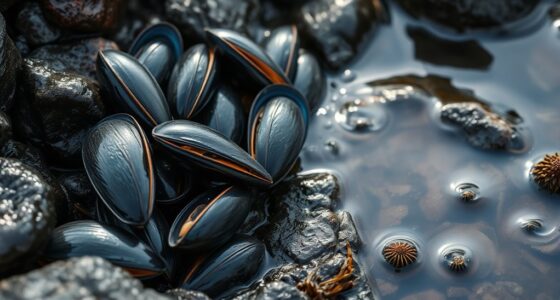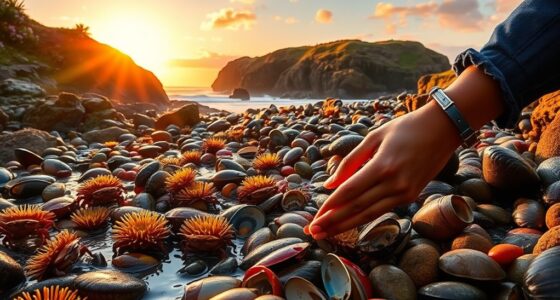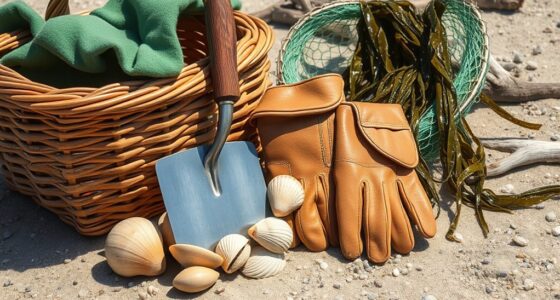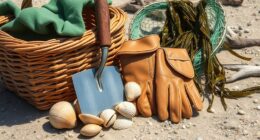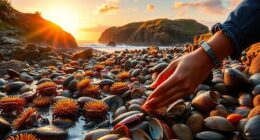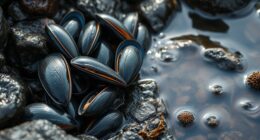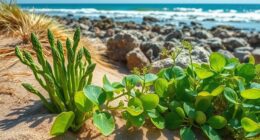Cooking with foraged coastal ingredients offers fresh, vibrant flavors straight from the shoreline. Use simple techniques like steaming, grilling, or sautéing to highlight the natural tastes of shellfish, seaweed, and wild herbs. Focus on seasonal harvests and responsible gathering to preserve the ecosystem while creating delicious, minimal-fuss dishes. Incorporate herbs like rock samphire and sea-beet for added flavor and color. Explore more ideas to craft sustainable, seaside-inspired meals that celebrate nature’s bounty.
Key Takeaways
- Rinse shellfish and seaweed thoroughly before cooking to remove grit, sand, and contaminants.
- Use simple cooking methods like steaming, sautéing, or grilling to preserve natural coastal flavors.
- Season minimally with lemon, sea salt, and olive oil to enhance freshness and oceanic qualities.
- Incorporate wild herbs and seaweeds into broths, stews, or garnishes for flavor and visual appeal.
- Practice sustainable harvesting by respecting seasonal restrictions and environmental guidelines to support ecosystem health.
Exploring the Rich Diversity of Coastal Foraged Foods

Coastal foraged foods offer a vibrant and diverse array of flavors that can elevate your cooking. When using wild foods, you tap into fresh, mineral-rich ingredients straight from the shoreline. Wild garlic, for instance, adds a pungent, savory note to dishes and is a popular find during coastal foraging. You can also harvest shellfish like mussels, winkles, limpets, and crabs, which are sweeter and more flavorful when collected from the wild. Seaweeds such as rock samphire and sea-beet provide bright, nutritious options that require gentle plucking or rinsing before use. Using wild, coastal foraging techniques, you learn to respect seasonal restrictions and harvest responsibly, ensuring these treasures remain abundant for future foragers.
Essential Techniques for Harvesting Seaweed and Shellfish
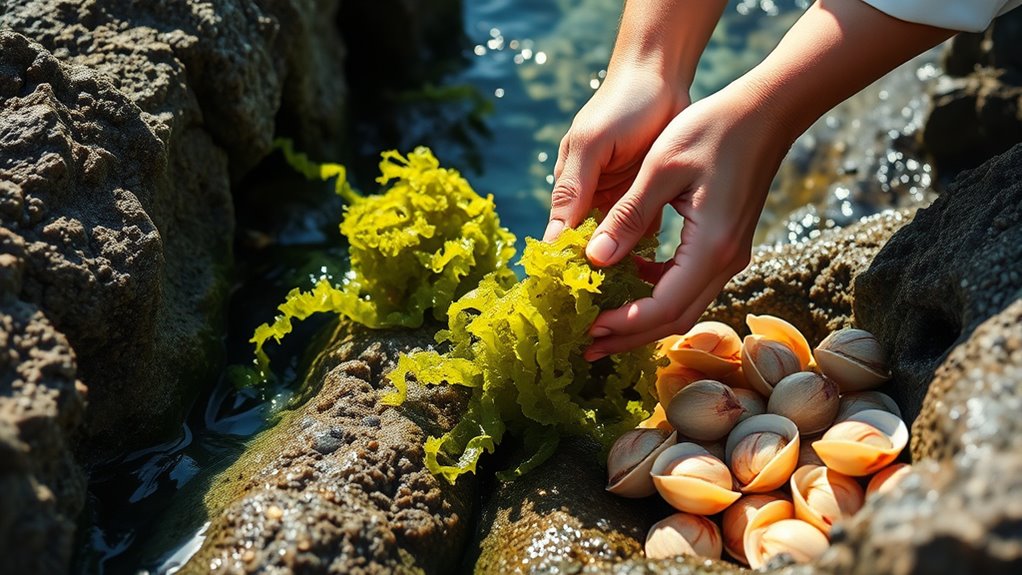
To make sure you harvest seaweed and shellfish responsibly and at their freshest, it’s vital to follow proper techniques. First, always forage during low tide for easier access and peak freshness. Second, rinse shellfish thoroughly in seawater or salted water to remove sand, grit, and contaminants. Third, use a sturdy, short-handled knife or shellfish lever to carefully pry limpets and mussels from rocks without damaging the ecosystem. Fourth, when collecting seaweed, choose species like rock samphire and sea-beet from clean, unpolluted waters, avoiding polluted areas or busy ports. Keep in mind that responsible foraging tips include handling your finds gently, avoiding overharvesting, and leaving enough behind to sustain future foragers. Additionally, selecting equipment with good color accuracy ensures you accurately identify and select the freshest, highest-quality seaweed and shellfish. Proper foraging techniques help minimize environmental impact and promote sustainable harvesting practices. Being aware of harvesting regulations in your area ensures compliance and supports conservation efforts. Understanding the importance of seasonal timing can also help you harvest at the peak of freshness and nutritional value. Incorporating local knowledge can further enhance sustainable practices and help you make informed harvesting decisions. These techniques ensure you harvest sustainably and with respect for coastal environments.
Simple Preparations to Highlight Natural Flavors

When preparing coastal ingredients, the key is to use simple techniques that preserve their natural oceanic flavors. Wild food shines when you keep preparations straightforward, allowing its inherent qualities to stand out. Rinsing seafood and seaweed thoroughly in seawater followed by tap water removes sand and impurities without dulling their delicate taste. Light cooking methods like steaming mussels with garlic and seaweed or sautéing limpets with white wine enhance flavors while maintaining freshness. Minimal seasoning—just a squeeze of lemon, a drizzle of olive oil, or a pinch of sea salt—lets the briny, umami notes shine through. Quick techniques such as grilling shellfish or stir-frying sea-beet emphasize their seaside origins, making their natural flavors the star of your dish. Additionally, understanding the benefits of hydration and nourishment can help you select the best ingredients to enhance flavor and texture. Incorporating modern automation techniques, like automated timers or temperature controls, can streamline preparation and ensure consistency in your dishes. Recognizing the importance of freshness in coastal ingredients ensures vibrant flavors and optimal texture in every bite.
Creative Recipes Using Wild Coastal Ingredients

Wild coastal ingredients offer a wealth of flavor possibilities for your cooking. You can craft inventive dishes with freshly harvested shellfish, seaweed, and foraged plants to add depth and vibrant color. Experimenting with these ingredients transforms traditional recipes into exciting, ocean-inspired creations. Incorporating aesthetic dinnerware and serveware can enhance your presentation and make your dishes even more appealing. Exploring foraged coastal ingredients can also introduce you to a variety of unique flavors and textures that elevate your culinary creations. Utilizing tea accessories and merchandise such as elegant teapots or cups can add a refined touch to your coastal-inspired meals and gatherings. Additionally, understanding wild ingredient sustainability ensures that your foraging practices support ecosystem health and resource availability, which is essential for maintaining the abundance of wild coastal ingredients.
Coastal Ingredient Varieties
Coastal ingredients such as mussels, winkles, limpets, and seaweed offer a wealth of flavors and nutritional benefits, making them ideal for creative culinary uses. You can explore different types of seaweed like kelp, rock samphire, and sea-beet, each adding unique umami and texture. When foraging, make sure to identify the right wild ingredients and harvest them at the *prime* time—spring and early summer are best. These ingredients can be transformed into delicious dishes, such as seaweed salads, mussel broths, or limpets cooked in white wine. Incorporate olive oil to enhance flavors and even try making nettle soup with fresh coastal greens. Wild ingredients allow you to create truly *superior* recipes that celebrate the flavors of the coast. Foraging also benefits from understanding sustainable harvesting practices, which can be informed by knowledge of environmentally responsible harvesting to ensure environmental balance. Additionally, understanding safety regulations is essential to avoid potential hazards when collecting wild coastal ingredients. Incorporating mindful harvesting practices can further support ecological sustainability and the health of coastal ecosystems. Using diverse designs in your kitchen tools, like specialized pots and containers, can further enhance your culinary experience and ensure proper preparation of these delicate ingredients.
Wild Seafood Preparation
Harnessing the fresh flavors of foraged shellfish and seaweed transforms simple ingredients into vibrant, flavorful dishes. When working with WILD seafood like mussels, winkles, and limpets, focus on proper cleaning—rinse them in seawater then tap water—to guarantee safety and maintain their delicate taste. Cooking methods such as steaming mussels with garlic and sea herbs or simmering limpets in white wine bring out their natural sweetness and umami. WILD seaweed varieties like rock samphire and sea-beet can be incorporated into broths, salads, or used as natural seasonings. Incorporating an understanding of art theory related to sensory experience can deepen the appreciation of the textures and flavors involved. Combining these ingredients with herbs and wild plants allows you to craft inventive recipes that highlight freshness and simplicity, celebrating the bounty of the coast in every dish.
Creative Dish Ideas
Creative dishes that highlight foraged coastal ingredients allow you to craft vibrant, flavorful meals with minimal fuss. You can showcase their natural flavors through simple yet impressive recipes.
- Prepare garlic-steamed mussels or limpets, letting their fresh taste shine.
- Toss seaweed into salads or use it as a garnish for seafood plates, adding texture and umami.
- Make hearty broths or stews with crab and shellfish, infusing them with wild herbs like rock samphire or sea-beet.
- Create seaside-inspired snacks such as seaweed crackers or dried seaweed leathers flavored with wild herbs and salty shore air.
These ideas turn foraged ingredients into delicious, authentic dishes, celebrating the coast’s bounty with ease.
Sustainable Practices and Respectful Foraging Habits

Practicing sustainable foraging habits is essential to protect marine ecosystems and guarantee future harvests. Always gather shellfish and seaweeds during low tide, and avoid over-collecting so resources can naturally replenish. Use sharp, sturdy tools and gentle techniques when collecting shellfish like winkles and limpets to minimize environmental disturbance. Respect local regulations and seasonal restrictions; these rules help safeguard native marine populations for future foragers. Rinse all coastal ingredients thoroughly in seawater, then tap water to remove sand, salt, and contaminants before cooking. Leave smaller shellfish and delicate plants behind to allow their populations to recover. Being aware of harvesting guidelines can further support sustainable practices. Additionally, paying attention to seasonal patterns ensures that foraging activities occur during times when marine life is most resilient. Incorporating responsible foraging into your routine promotes healthy ecosystems and ensures that coastal resources remain abundant for generations to come. Monitoring market conditions can also help you make informed decisions about when and where to forage most sustainably. By following these respectful practices, you ensure the sustainability of coastal ecosystems while enjoying the bounty of the shoreline.
Seasonal Guides to Coastal Foraging Opportunities
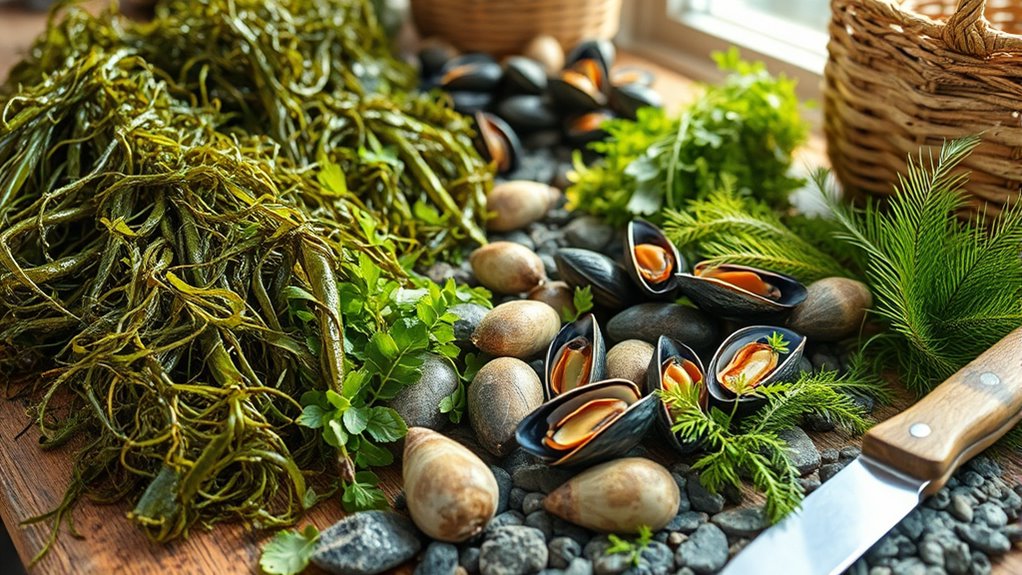
The best times to forage along the coast depend heavily on the season, as different species become available and abundant throughout the year. Knowing when to seek each ingredient can boost your harvest and flavor.
- Spring to early autumn: Harvest mussels and winkles during low tides, when shellfish populations are at their peak.
- Late spring to early summer: Collect sea-beet and rock samphire, which are most abundant and nutritious now.
- Autumn: Gather edible crabs and crustaceans, as their numbers peak and flavors intensify.
- Winter: For hardy species like laver and certain seaweeds, forage year-round but with caution, ensuring proper identification and handling.
Seasonal restrictions and weather also influence what’s available, so plan accordingly.
Frequently Asked Questions
Is Foraging for Food Safe?
Foraging for food can be safe if you’re careful and well-informed. You need to identify plants and seafood correctly to avoid toxic or inedible species. Always harvest from clean areas, follow local regulations, and respect seasonal rules. Properly cleaning and cooking your finds reduces health risks. When unsure, consult experienced foragers or trusted resources to prevent accidents and guarantee your foraged foods are safe and sustainable.
What Is It Called When You Find Food in the Wild?
Imagine you’re in a real-life fairy tale—finding food in the wild. When you discover edible plants, fungi, or seafood in nature, it’s called foraging or wildcrafting. You’re fundamentally hunting for wild edibles, recognizing and gathering them to use later. This practice involves identifying safe-to-eat resources and harvesting them responsibly, often called wild harvesting or natural foraging, which connects you to ancient skills and the environment.
What to Avoid When Foraging?
When foraging, you should avoid harvesting during closed seasons or in protected areas to prevent ecological damage and legal trouble. Stay away from polluted sites, such as near sewage outlets or busy roads, to guarantee safety. Don’t pick wild mushrooms unless you’re 100% sure about their identification, and avoid consuming dead, damaged, or foul-smelling marine creatures. Ultimately, don’t overharvest from one spot to help keep ecosystems balanced and healthy.
How to Forage for Food in the Wilderness?
When foraging in the wilderness, you should first identify edible plants and wildlife, ensuring you’re familiar with local guidelines. Use a sharp knife or levers to harvest sustainably, avoiding damage to the environment. Rinse your finds thoroughly in clean water to remove dirt and contaminants. Only take what you need, and leave enough behind to support the ecosystem. Always prioritize safety and respect for nature during your foraging adventures.
Conclusion
By foraging responsibly along the coast, you not only connect with nature but also enjoy fresh, flavorful ingredients. Did you know that sustainable harvesting can help maintain coastal ecosystems? With over 1,000 edible seaweed species worldwide, there’s a wealth of flavors waiting to be explored. Embrace respectful foraging habits, and you’ll contribute to preserving these vibrant habitats while creating delicious, unique dishes that celebrate the bounty of the shoreline.


